PFA warns W-League: reform structures now or play catch-up forever

The W-League is languishing inside a “strategic vacuum” and will slip even further down the global pecking order of women’s sport unless its structure is overhauled, an Australian players’ union report has found.
The findings, seen by Guardian Australia and due to be released on Wednesday as part of Professional Footballers Australia’s annual W-League report, highlight the need for the competition’s new owner, Australian Professional Leagues, to make immediate changes to its design if it is to keep up with the world’s major leagues – and other domestic codes – as investment pours into women’s sport internationally.
Related: PSG Féminines win French league for first time, ending Lyon’s run of 14 titles
“This report provides a timely synopsis of where the W-League has progressed to after 13 seasons under Football Australia’s operation – and where the opportunities lie for next season, which will be the first in a new era of independence,” PFA co-chief executives Kate Gill and Beau Busch wrote in the report’s foreword.
“The club owners are inheriting a competition design that has largely stagnated. Since Melbourne City entered the competition in 2015 – six years ago – no new teams or expansion plans have been unveiled, at a time where the W-League is slipping down the global pecking order for female professionals.
“In this strategic vacuum, other sports have strengthened or emerged from nothing; five new female professional leagues have materialised in Australia in the past five years – and one, the AFLW, rapidly expanded from eight to 14 teams.
“With [the 2023 Women’s World Cup] on the horizon, there is no better – or rather, no other – opportunity to ensure we re-establish the W-League as the premier sporting competition for our footballers.”
The PFA’s report is timely in light of Fifa’s recent release of its inaugural Women’s Football Benchmarking Report, a snapshot of the global women’s club landscape that distils its trends and themes in order to help clubs and leagues grow.
Some of the PFA’s findings, particularly of the most recent W-League season, were unsurprising. Given the impact of the coronavirus pandemic, the number of international players on W-League rosters almost halved from the previous season. The financial aftershocks of the pandemic also filtered down to the players, with a 14% decrease in player payments across the league.

However, there were some silver linings which emerged from these wider difficulties. The lack of more experienced international players meant more opportunities for young, home-grown talent to receive more match minutes, with players aged 18-24 enjoying a 38% increase in playing time compared to last season.
This finding is especially significant given Football Australia’s performance gap report found a growing gulf between the current “golden generation” of Matildas and those emerging behind them in terms of match minutes, and access to high-level competition and full-time professional environments.
Indeed, the PFA implies young Australian players should continue to receive significant game time by comparing the W-League’s most recent season with the 2012-13 season, wherein a number of senior Matildas including Alanna Kennedy, Caitlin Foord, Sam Kerr, Kyah Simon and Steph Catley received a similar number of league minutes while aged 22 or younger.
Some of the PFA’s recommendations aligned with those of Fifa, including the need for more matches; a more secure, full-time professional calendar; increased remuneration; and raising minimum workplace standards and facilities for players.
Player remuneration is a particular point of tension. Compared with participants of other women’s football leagues such as the NWSL, the FAWSL and France’s Division 1 Arkema, W-League players earn far less.
The difficulty in earning a living in the W-League is cited in the PFA report as one of the primary reasons players would consider leaving the game early, with 94% of those surveyed saying “more money from football” would prolong their careers.
Related: Women’s transfer window summer 2021 – all deals from Europe’s top five leagues
One of the most surprising findings was in game viewership. Despite the loss of senior Matildas and internationals, as well as repeated broadcasting issues, the 2020-21 season attracted the most television viewers than the past three seasons. The average number of combined viewers per game was 23,081 while the grand final attracted 99,069 viewers across ABC and Fox Sports – almost 20,000 more than the next-highest season in 2018-19.
This is arguably due to the quality of the competition itself. In the report’s technical section, the PFA found that the W-League is one of the highest-scoring top-tier women’s leagues, with 3.16 goals per game, and has fewer goalless draws than the FAWSL, NWSL and Norway’s Toppserien. It also leads the selected leagues in chances created and individual dribbles per match, suggesting an exciting, action-packed competition for viewers.
The PFA therefore hopes the W-League’s new broadcast deal with ViacomCBS, owner of Channel 10, will “maximise the immediate and long-term opportunity for the W-League”.
“We cannot simply rely on opportunism or hoping that random positive trends – such as player match minutes – emerge without there being a broader vision and strategy to support it,” Gill and Busch said.
“With a new Collective Bargaining Agreement with the clubs, broadcast deal and a once-in-a-lifetime opportunity for Australian football to host the biggest international tournament [the 2023 Women’s World Cup], there is a huge moment for the W-League to maximise its potential and build a genuine football legacy.”

 Yahoo Sport
Yahoo Sport 





































